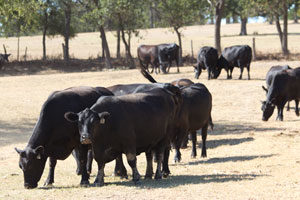A series of in-depth, educational programs will be held across the state throughout the month of April and throughout the year, Gill said. Kickoff programs are scheduled for Midland, Yoakum, Alice, Graham, Abilene and Athens. For complete schedules and online registration, visit agriliferegister.tamu.edu (Enter the keyword: beef).
Program topics include:
• Changes in lending policies that will impact availability of capital to reinvest in cattle
• Balancing forage recovery with cattle inventory recovery
• Systematic approach to evaluating options for securing replacement females
• Developing a logical and systematic system to evaluate the worth of available replacement females
The program sessions will also include discussions on such issues as herd health, biosecurity and building strategic inventory flexibility into an operation.
Another critical area of concern is generational turnover, Gill said. The ongoing drought has been so severe that many producers have decided to not go back into the cattle industry, he said.
“It’s important to long-term sustainability of the beef industry that we do not keep this range/pasture land out of cattle production,” he said. “One special session will be devoted to the topic of how to develop a long-term relationship between landowners and land lessors.”
Gill said there are a large number of young men and women who want to go into ranching, but who do not have the capital or, in some cases, the experience to start an operation.
“Developing partnerships with family members or others in the community will allow a new generation of ranchers to emerge during this recovery process,” he said. “We will address this issue and the challenges that lie ahead.”
The program sessions will also discuss additional uncertainty with both weather patterns and intentions of state beef producers following the devastating 2011 drought, Gill said.
“Recent surveys indicate that as many as 25 percent of producers who have sold cattle due to drought do not intend to go back into beef production and another 10 percent to 15 percent indicate they may seek alternative livestock enterprises if they do go back into production.”
Gill said whether this property is taken out and put into real estate development, recreational or wildlife use or sits idle, it “will have long-term implications on the future of the Texas beef cattle industry.”
Other factors such as competing land use, economics, drought and availability of financing have all contributed to the decline in livestock inventories, he said.
“However, the Texas livestock industry is not solely dependent upon the livestock produced within the state,” Gill said. “The stocker and finishing phases depend upon inventory that comes from a large geographical area.”
In particular, Gill said the supply of calves from the southeastern states and Mexico are critical to supplying inventory to support the grazing of warm season forages during spring and summer programs and winter annuals during the fall and winter grazing cycle.
“These cattle, along with the calves they produce within the state, supply the cattle feeding and packing industry primarily in the High Plains and South Texas regions,” Gill said.
Further erosion in cattle inventories will result in loss of infrastructure within all of these sectors, he said.
“As world demand for proteins continues to increase, the need is for more beef cattle numbers and increasing supply of high-quality protein to meet the increasing demand.”
Gill said it’s important that as herds are rebuilt, producers take into account the value and need for environmental adaptability of cows used to rebuild the cowherd. The educational programs offered will address this issue.
“Research information from the past on cow longevity, retained heterosis and ongoing work on cow efficiency will be invaluable to producers as cowherds are rebuilt,” he said. “This type of information will be shared in the programs offered across the state.”
For more information, visit rebuilding.tamu.edu/. ![]()
—AgriLife Today; agrilife.org/today
PHOTO
Last year's drought in Texas was one of the longest on record in that state's history. Dried pasture throughout the state led to an inventory loss of almost 13 percent as of Jan. 1, 2012. Staff photo.









